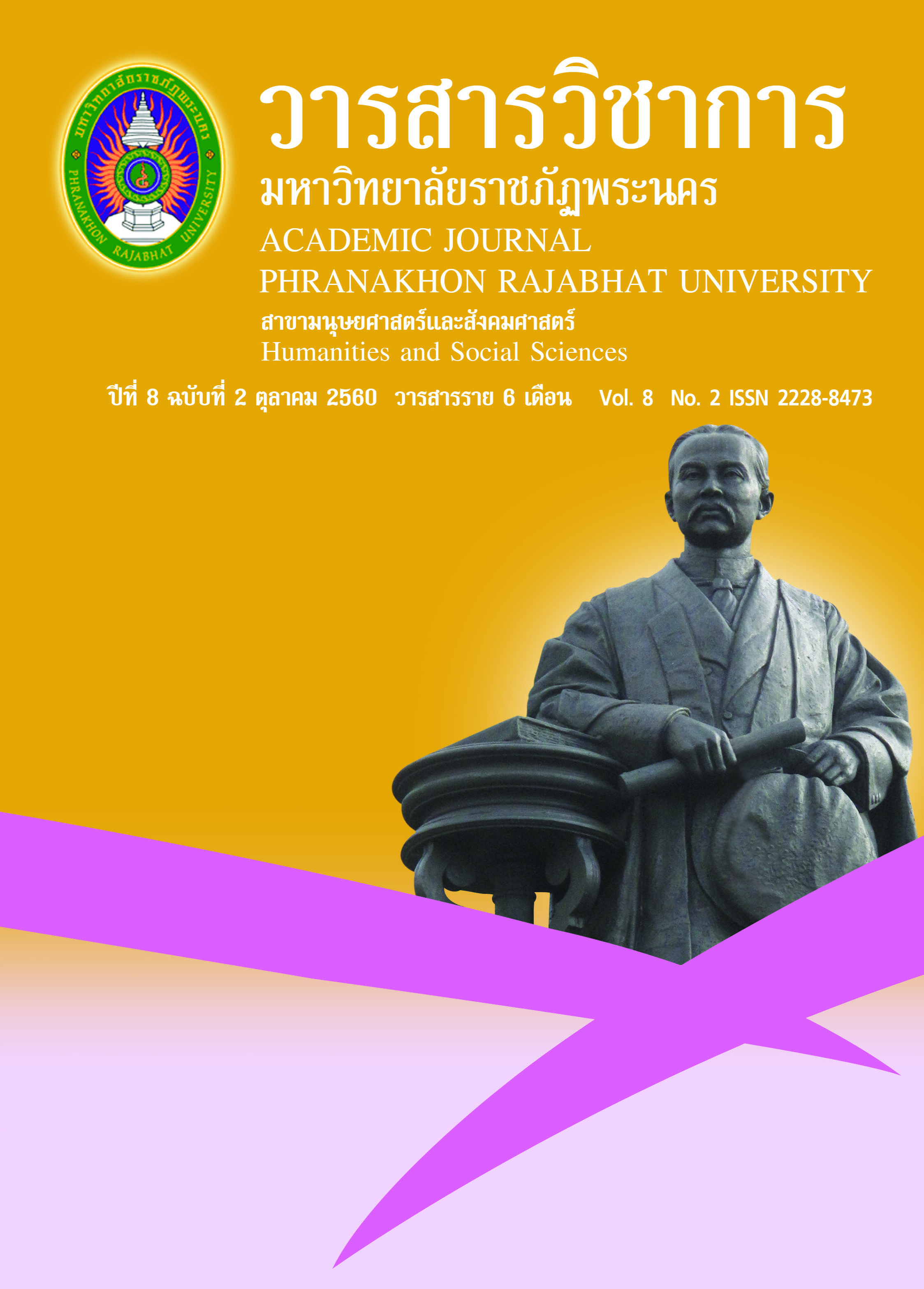รำโทน
Keywords:
Ramtone, The cultural context, effected Analyz ident itiesAbstract
การวิจัยครั้งนี้มีวัตถุประสงค์เพื่อศึกษา1) บริบททางวัฒนธรรมที่มีผลต่อการรำโทน 2) รูปแบบการเล่นรำโทนและวิเคราะห์อัตลักษณ์ของการเล่นรำโทนในภาคกลาง แบบของการวิจัยใช้วิธีการวิจัยเชิงคุณภาพ ผู้ให้ข้อมูลสำคัญได้แก่ ผู้เชี่ยวชาญทางด้านนาฏศิลป์ไทย จำนวน 2 คน ผู้ทรงคุณวุฒิการเล่นรำโทน จำนวน 15 คน และเอกสารที่เกี่ยวข้อง เครื่องมือที่ใช้ในการวิจัย คือแบบสัมภาษณ์เกี่ยวกับการเล่นรำโทนในการวิเคราะห์ข้อมูลโดยการวิเคราะห์เนื้อหา
ผลการวิจัยพบว่า 1) บริบททางวัฒนธรรมที่มีผลต่อการรำโทนพบว่า รำโทนสันนิษฐานว่ามีการเล่นมาตั้งแต่สมัยอยุธยา และเล่นกันอย่างเเพร่หลายไปจนเกือบทุกที่พื้นที่โดยเฉพาะในภาคกลาง ต่อมารำโทนได้รับอิทธิพลจากบริบททางวัฒนธรรม นโยบายรัฐนิยมในยุคของ จอมพล ป. พิบูลสงคราม จึงทำให้มีการเปลี่ยนแปลงโดยปรับปรุงและการพัฒนาจากรำโทนแบบชาวบ้าน มาเป็นรำวงตามแบบฉบับของกรมศิลปากร จึงถือได้ว่ารำโทนเป็นต้นแบบของรำวงในรูปแบบต่าง ๆ ตลอดมาจนถึงปัจจุบัน 2) รูปแบบและอัตลักษณ์ของการเล่นรำโทนในภาคกลางพบว่า เป็นการเล่นเพื่อความสนุกสนาน ได้รับความนิยมสูงสุดในช่วงสงครามโลกครั้งที่ 2 โดยมีโทนเป็นเครื่องดนตรีกำกับจังหวะหลักร่วมกับฉิ่งและกรับ อันเป็นที่มาของการเรียกว่า “รำโทน” แต่ในปัจจุบันมีการใช้รำมะนาตีกำกับจังหวะแทนโทนเนื่องจากมีเสียงดังและไพเราะ รูปแบบในการเล่นจะรำเป็นวงกลม วนซ้ายรอบผู้ร้องและผู้บรรเลงเครื่องดนตรีกำกับจังหวะ ลักษณะการรำเป็นคู่ชายหญิง โดยผู้รำจะทำท่าใช้บทไปตามเนื้อเพลง บทเพลงเป็นเพลงที่สั้น ๆ จำง่าย บทร้องแสดงการเกี้ยวพาราสี สะท้อนถึงวิถีชีวิตในยุคนั้น แต่งกายตามแบบวิถีชีวิตในท้องถิ่นของชาวบ้านและแต่งกายตามโอกาสที่เล่น นิยมเล่นในงานมงคล งานประเพณี และเทศกาลต่าง ๆ โดยเฉพาะเทศกาลสงกรานต์ ในสถานที่เป็นศูนย์รวมของท้องถิ่น สืบทอดโดยการสังเกต ฟัง จำ และปฏิบัติตามต่อกันมา ปัจจุบันมีการเผยแพร่ให้กับผู้ที่สนในทั้งในท้องถิ่นและต่างท้องถิ่นในเชิงบริการวิชาการ
The purposes of this research were to study: 1) The cultural context effected to Ramtone. 2) to study performce form of Ramtone and analyz ident ities show how each component in culture effects to this kind of dance. Research methodology is by qualitative research. Population is thaidance luminaries number 2 people, Ramtone luminaries number 15 people and related document. The research instrument were the interviews the data were analyzed by content analysis.
The results were as follows: 1) Cultural context effected to Ramtone Analysis revealed that performance evidence of Ramtone had occurred since Ayudhaya period and spearded over the area especially in the central part of Thailand. Later on, state convention policy of field Marshal Plaek Phibunsongkhram, Ramtone influenced by cultural context that had caused changes by revise and improve from traditional Ramtone to Ramvong, a slow round dance continuously moving in a circular manner, and incorporates graceful hand movements and simple footwork which refered to Fine Arts Department therefore it is said that Ramtone is elementary in developing in any kind of dances in Thailand until present time. 2) Performce form of Ramtone and analyz ident ities show how each component in culture effects to this kind of dance. Ramtone is famous and known for creating fun in between the period WWII. Thon, hand drum played in Thai classical music which made of a ceramic or wooden body is mainly used to control rhythm. Thon is used to play together with ching and grap therefore it is called as Ramtone. Nowadays, Rammana is being used in order to control rhythm instead of Thon because it creates louder and medolically sound. The form of Ramtone is usually dance in circle. Singer and musician are usually control beats by gyrating to the left and it is a paired up dance between male and female, dancer will dance along with the song and each song will not be very long to make it easy to memorize in order to chatten up with each other between male and female majory reflected the way of their livings during the period of time. Customize in pattern of local people lifestyle and its circum stamnces of performance. Ramtone is generally played at the auspicious ceremony and festivals, especially, Songkran Festival which festival is centralized of people in the area. Ramtone inherited from generations to generations by notice, listen, memorize and practice. Moreover, Ramtone will be taught to anyone interested in the area or surrounding always. However, each component depends on how people in the area live.
References
รวีทิวา ไวยนันท์. (2552). การแพร่กระจายวัฒนธรรมการแสดงรำโทน จังหวัดลพบุรี. ปริญญา ศิลปศาสตรมหาบันฑิต. สาขาวิชาดุริยางค์ไทย. จุฬาลงกรณ์มหาวิทยาลัย.
ศิริวัฒน์ ฉัตรเมธี. (2547). การวิเคราะห์เพลงรำวงมาตรฐาน. ปริญญาศิลปศาสตรมหาบัณฑิต.
สาขาวิชาดนตรี บัณฑิตวิทยาลัย, มหาวิทยาลัยมหิดล.
อมรา กล่ำเจริญ. (2548). รำโทน กรณีศึกษาเฉพาะอำเภอสามโก้ จังหวัดอ่างทอง. งานวิจัย
โปรแกรมวิชานาฏศิลป์, มหาวิทยาลัยราชภัฎพระนครศรีอยุธยา.
Downloads
Published
How to Cite
Issue
Section
License
"บทความวิชาการในวารสารฉบับนี้ ถือเป็นความรับผิดชอบของผู้เขียนเท่านั้น"
สงวนลิขสิทธิ์ตามพระราชบัญญัติลิขสิทธิ์




